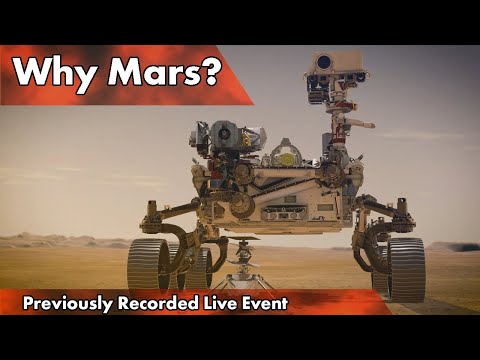Why Go To Mars?

All right ,well greetings, everyone. Welcome to our special Mars livestream event. uh My name is Mike Murray, I'm with the Delta College Planetarium in Bay City, Michigan, and we're talking about the red planet because another exciting chapter in Mars exploration is going on right now. And so you'll have a chance to uh ask us some questions live. My cohort here at the planetarium, Brian Kennedy, be keeping an eye on the chat window, so if you have any questions as we're going along in the program please feel free to go ahead and drop them in there, and we'll try to answer for them for you during the program, and if we have a little bit of time at the end of the show at the end of the presentation we'll try to answer some questions for you live at the end as well. So again, thank you for joining us.
Well as you can probably know, Mars has long actually been a very unique and fascinating world. It's actually still visible right now as an orangish red star over in the west after sunset. But it does change its place among the stars, because it's a planet that orbits around the Sun. Over time Mars like the other planets not only slips in one direction against the stars, but it even seems to stop and loop, what we call a retrograde motion, and after a few weeks it can seem to loop back, and as you can imagine our ancestors were very confused by this, or inspired maybe you could say because they were the only star-like objects to move like this.
And so this of course we know today is an optical illusion, but to our ancestors this was something very mysterious and very special. Our ancestors, our distant ancestors didn't know why the motions happened. They gave them you know special deity designations, if you will. Probably the best and known as the roman god of Mars, as one of the reddest as one of the uh the wandering stars that was also red in color though that gave Mars a very special distinction in history. As soon as telescopes came around, one of its first targets was the red planet. In fact a wealthy Bostonian businessman named Percival Lowell had a major observatory built in Flagstaff, Arizona in the 1890s, almost exclusively because of his fascination with Mars.
Lowell's imagination of course ran wild, who imagined seeing an intricate network of canals. What he thought were intelligent civilizations building canals to bring water from the poles to the thirsty cities near the equator where it was warmer. His wildly persuasive lectures inspired H.G. Wells to write his famous classic "The War of the Worlds" in 1897. That in turn inspired many other writers.
Mars being, you know, the one planet where we could imagine there being life, our imaginations went pretty wild. Artists could imagine maybe even space hotels things like that on the red planet. Radio plays, like Orson Welles dramatic reenactment of The War of the Worlds in 1938, so all of this excitement just continued which went right into the the movies. Well all this created, what I like to call, "imagination capital": The insatiable fascination with space travel - and there was a lot of it especially in the 1950s, as you can see like in here in this picture from disneyland in the tomorrowland section of the 1950s. Well you take that and combine it with the explosion of social progress going on after world war ii and the swift advances being made in science and technology, and you get the dawn of the space age. Our first ventures into space may have been Sputnik, and Explorer, and the space race, but it wasn't long before we were reaching toward the planets, and you could probably guess one of our first destinations.
In the early 1960s, even the 200-inch telescope on Mount Palomar, which at that time was the largest in the world, couldn't make out enough detail on Mars for us to determine whether it had any kind of life or seasons or some people wondered if the changing dark patches were vegetation. There were all kinds of - of still wild ideas, interesting speculation about what could be on the planet's surface. In 1964, NASA launched the first spacecraft to do a quick flyby of the red planet, Mariner 4. It had a very low resolution television camera, and our first impressions, unfortunately, were kind of disappointing. We saw what appeared to be a lot of craters, giving us the impression that Mars was more like the Moon, but fortunately that impression didn't last.
In fact dozens of orbiters, and landers, and rovers have been sent to Mars now by many different countries, more than any other planet. And that included a lot of spacecraft that didn't make it, but we've had a pretty good track record in recent years, especially NASA. All of that new exploration, and new and better spacecraft, surprised us with a variety of Earth-like features. So even though today we tend to see a dry desert world, it does have a lot of amazing geology and history. Mars may only be half the size of the Earth, but it turns out to be a world of gigantic features. Olympus Mons, the volcano dormant, probably extinct, nearly three times higher than Mount Everest.
There's the Mariner Valley: a canyon system longer than the width of the United States. Polar ice caps that grow and fade with the Martian seasons, and a lot of which has liquid water but also frozen carbon dioxide - dry ice. But we also found evidence of drainage channels, proving that mars once had a thicker atmosphere and flowing water.
With a warmer, wetter Mars the question naturally comes up, "could life have gotten a foothold way back then?" NASA's latest rover, named Perseverance, just landed last week to help us answer that and many other questions. Perseverance landed in a region called Jezero Crater, with strong evidence of riverbeds and shorelines. Some very strong evidence of flowing water.
There's the spot where Perseverance landed. The color coding here marks minerals left behind from the presence of water including clay. So the evidence is already pretty convincing, but we needed to get a spacecraft there. Now here's an artist's conception of what Jezero Crater may have looked like 3.5 billion years ago. The drainage feature there on the right created a delta of sediments that Perseverance is going to analyze.
Of course in this image, it's under water but today you can see that delta, again with the evidence of drainage features. And here is the path that they hope to direct Perseverance on, to go through the shorelines, to go through some of the sediments and layers, and eventually climb to higher and higher elevations to see all the different evidence of where water had affected the surface. So that path that you're looking at is what's planned over the course of a two-year mission, but if it's anything like its predecessor, the Curiosity rover, hopefully it will be there working on the Martian surface for a lot longer. There were cameras mounted all over the place on the rover, so that for the first time we could actually see the descent and landing from various cameras that were positioned. So let's go ahead and watch that actual video taken from cameras mounted on the spacecraft during descent and landing, because it's going to be the first time that it was able to record this part of the flight, and it was realigned so that you could see what the cameras were seeing at that time.
So here we go. NASA Voiceover: We're starting this straighten up and fly right maneuver where the spacecraft will jettison the entry balance masses in preparation for parachute deploy and to roll over to give the radar a better look at the ground. JPL Mission Control: - indicates chute deploy. NASA Voiceover: The navigation has confirmed that the parachute has deployed, and we are seeing significant deceleration in the velocity.
Our current velocity is 450 meters per second at an altitude of about 12 kilometers from the surface of Mars. JPL Mission Control: Heat shield sep. NASA Voiceover: Perseverance has now slowed to subsonic speeds and the heat shield has been separated. This allows both the radar and the cameras to get their first look at the surface.
Current velocity is 145 meters per second and an altitude of about 10 km - 9 and a half kilometers above the surface. JPL Mission Control: Nav filter converge. Velocity solution 3.3 meters per second altitude 7.4 kilometers. NASA Voiceover: Nav has radar lock on the ground.
Current velocity is about 100 meters per second 6.6 kilometers of the surface. Perseverance is continuing to descend on the parachute. We are coming up on the initialization of terrain relative navigation and subsequently the priming of the landing engines. Our current velocity is about 90 meters per second at an altitude of 4.2 kilometers. JPL Mission Control: OVF valid.
NASA Voiceover: We have confirmation that the lander vision system has produced a valid solution and part of terrain relative navigation. JPL Mission Control: Priming. NASA Voiceover: We have priming of the landing engines. JPL Mission Control: Back shell Sep. NASA Voiceover: Current velocity is 83 meters per second at about 2.6 kilometers from the surface Mars.
We have confirmation that the back shell has separated. We are currently performing the divert maneuver. Current velocity is about 75 meters per second at an altitude of about a kilometer off the surface of Mars.
JPL Mission Control: Here in Safety Bravo. NASA Voiceover: We have completed our terrain relative navigation. Current speed is about 30 meters per second altitude of about 300 meters off the surface of Mars. We have started our constant velocity accordion, which means we are conducting the sky crane - about to conduct the sky crane maneuver. Sky crane maneuver has started. About 20 meters off the surface.
JPL Mission Control: we're getting signals from MRO. Tango-Delta! NASA Voiceover: Touchdown confirmed! Perseverance safely on the surface of Mars! Ready to begin seeking the sands of past life! Mike: Wow. So I don't know about you all but every time I watch that I get goosebumps. It doesn't matter how many times, and it's just amazing to be able to actually see what it was like - uh - for the first time with video cameras attached, and what was one of the things that was interesting is that if you had a chance to see the rocket engines that were on the backpack, you know, a lot of the animations show what looks like yellow flames and such coming out of the nozzles, but in fact on Mars, because of the thin atmosphere, it looked like it was just perfectly transparent. So that was one of the really interesting, uh notes.
And of course, that kind of design, with that kind of a backpack is only possible to do on Mars. There's no way of really being able to test that completely on the Earth, because of our gravity and our uh atmosphere and such. And so the only way they were ever going to know if that was truly going to work was if they actually tried it. And it was first done on the Curiosity rover.
This is only the second time that we've ever landed a spacecraft on the surface like this. So very exciting time. And here we have a section of the first color, the first color panorama taken from the surface.
Off in the distance, you can see the plateau behind the shoreline of what used to be the lake in Jezero Crater. This will be its destination, It's driving direction. The plateau there above the rim of Jezero Crater. And so, uh, the rover will be staying in this position for probably, uh, a while because there's so much that still needs to be checked out with all of its instruments, but it is uh - uh sending back some amazing pictures not just with its navigation cameras, but also with its big high resolution uh mastcam.
This is from the um one of the hazcams, and another thing that is on this rover that has not been on others is a microphone. [Low bass sound of wind on Mars] And I don't know if you can hear that, It's kind of low in the background, but these were some of the first recordings that were sent back. I've got a looping so you might have to turn up your volume and i'll stop talking.
[Low bass sound of wind on Mars] There, I don't know if you could hear that or not, but the if you want to download those recordings they are also on the Mars Perseverance Website. [Low bass sound of wind on Mars] And speaking of other firsts: there is a passenger that was carried by the rover. A helicopter drone called Ingenuity. And this is a little technology experiment designed to see if it's possible to fly and hover over the surface. Especially on a planet that has such an incredibly thin atmosphere.
Mars atmosphere is only about one percent the pressure of Earth's atmosphere at sea level. That's like the equivalent of being at a hundred thousand feet on the Earth. And so it's you can imagine, very difficult to try to get anything airborne but uh here's a little demonstration video of how they think it's going to work. Once they find a suitable location flat enough to serve as kind of a helipad the rover will release the helicopter to a couple a feet.
It'll have enough power to conduct several uh tests where they can try to go at higher altitudes and farther and farther distances. But this will be really exciting to see if uh such an experiment will work, because it would really help with the future reconnaissance. Perseverance isn't the only spacecraft that arrived at Mars this month. The United Arab Emirates succeeded in placing their first spacecraft in orbit around Mars. Quite a big celebration that they made of it there. And this is the first color image that their spacecraft, called Hope, took from orbit.
The Chinese also launched their first spacecraft to Mars called Tainwen-1. It went into orbit on February 10th. But uh Tianwen-1 is carrying a passenger, a capsule that will also head for the surface and land with a payload: a small rover of its own.
The landing is uh expected to take place in a few months probably sometime in the spring. So a lot of other countries still have active missions going on. The European Space Agency and many others have active uh especially orbiters. So this brings us back to our original question: why why is it that we even want to explore Mars and maybe even send astronauts there? While life across - or life arose I should say - on Earth, Mars experienced serious climate change. So studying the geology atmosphere and chemistry of Mars is going to help us learn whether life in the solar system is unique to our planet, or whether it can arise naturally under the right conditions. This could have far reaching implications for how we see our place and what it takes to get life started in the universe.
Another reasoning has been that we really get a lot of cutting-edge technologies from the space program. It's one of the greatest catalysts for technological innovation. Everything from global positioning systems and medical diagnostic tools to wireless technology and camera phones owe at least a part of their creation to the space program. And so there were a lot of very innovative creative uh technological solutions that had to come out for the Perseverance rover, and that that all comes back to help fuel new economies. The utilization of resources that are already on Mars is what would help humans to live and work there, not to mention fuel their expansion into other parts of the solar system.
That's going to be absolutely essential if we want to spend anything more than say a two-week exploration period. All right, now this one might sound kind of way out there, but something like space tourism is already gaining a lot of serious attention for here at Earth, so the idea of putting space hotels in orbit might be something that could eventually happen on Mars, especially if we solve some of the long-term issues of low gravity and radiation, because really if you think about it tourism can broaden human horizons in the same way international travel has exposed people to other lands and perspectives. And then finally, exploring space provides a means to satisfy our need and our thirst for knowledge, and to improve our understanding of ourselves, and our place, and our connection to the other elements in the universe. You know, we're all really intricately connected. We already know that about nature and and the ecosystems of the Earth but it's also true of the universe: everything that made up the planets and made up us came from stars.
And so, we have this this need, this connection of wanting to understand, and we can also understand a lot of the processes of our own planet a lot better by studying analogs on Mars. So it you know of course, you'll probably hear some of these these ideas and arguments that "well it would be nice to have another planet to live on in case some disaster were to unfold here on the Earth" whether it's natural from an asteroid or man-made, whatever the case and you know you hear this from people like Elon Musk and other visionaries, but that of course is not the only reason that we would be going to Mars. I like to look at all of these things together as uh as a way of keeping things moving, because progress in some of these cutting edge areas can come back and help us to address some of the biggest challenges and problems that we face here on the Earth.
So we really I think need all of them. So our first small steps on Mars, when we do get astronauts there hopefully, would be small scientific outposts and missions that would test our ability to function there. These could hopefully lead the way to larger settlements, with the means of living off the land, if you will, and conducting even more exploration into the questions of life on other worlds. So in other words, well that image of Mark Watney from the movie The Martian someday become a reality? I don't know.
It may not happen as quickly as as we want it to, but things will eventually develop and push us to get there. So if you go out and look into the west for the planet mars, it'll be up there near the Pleiades star cluster. It's a time to think about some of those ideas, what it means to us today. Mars can be a source of inspiration, a destination, a world with the promise of knowledge and innovation. So there's a lot to dream of, in terms of the possibilities. And by the way speaking of Mars and the Pleiades, be watching it over the next week.
It's going to be passing really close to that beautiful Pleiades star cluster of the Seven Sisters. All right. Well, I want to thank you all very much for joining us tonight for our little look at Mars, and by all means do keep uh looking at the Mars Perseverance website. There are so many pictures that are being uploaded there, almost daily now.
I think they're they're now up to hundreds, if not several thousand raw photos, that have been uploaded, but they're also putting up recordings of the sounds and the mastcam, which is the really high resolution uh camera uh on the the mast uh, is now starting to release images as well. So be sure to check those out. Remember that we do our live streams at least once a month, sometimes more often, and you can go onto our website and sign up for our e-newsletter to get notices or just check our Facebook page.
And we also post the recordings of these and many other specials on the planetarium's YouTube channel.
2021-03-13 05:07


